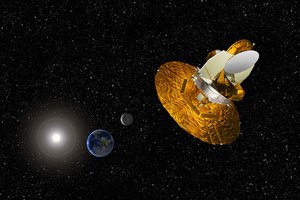WMAP
|
|
The Wilkinson Microwave Anisotropy Probe (WMAP) is a NASA satellite whose mission is to survey the sky to measure the temperature of the radiant heat left over from the Big Bang. The satellite was launched by a Delta II rocket on June 30, 2001, at 3:46 p.m. EDT from Cape Canaveral Air Force Station, Florida, USA.
The goal of WMAP is to map out minute differences in the Cosmic Microwave Background (CMB) radiation in order to help test theories of the nature of the universe. It is the successor to COBE and one of the series of medium-class explorer (MIDEX) satellites.
WMAP is named after Dr. David Wilkinson, a member of the science team and pioneer in the study of cosmic background radiation. The science goals of the WMAP broadly dictate that the relative CMB temperature be measured accurately over the full sky with high angular resolution and sensitivity. The overriding priority in the design was the need to control systematic errors in the final maps. The specific goal of WMAP is to map the relative CMB temperature over the full sky with an angular resolution of at least 0.3°, a sensitivity of 20 µK per 0.3° square pixel, with systematic artifacts limited to 5 µK per pixel.
To achieve these goals, WMAP uses differential microwave radiometers that measure temperature differences between two points on the sky. WMAP observes the sky from an orbit about the L2 Sun-Earth Lagrangian point, 1.5 million km from Earth.
This is the on the line from the Sun to the Earth, but at a larger distance from the Sun than the Earth, where the sum of the (larger) Sun's gravity and the (smaller) Earth's gravity is equal to the centripetal force needed for an object to have the same orbital period in its orbit around the Sun as the Earth, with the result that the object will stay in that relative position. Gravity from the Sun is 2% (118 µm/s²) less than at the Earth (5.9 mm/s²), while the increase of required centripetal force is half of this (59 µm/s²). The sum of both effects is balanced by the gravity of the Earth, which is here also 177 µm/s².
WMAP_spacecraft_diagram.jpg
This vantage point offers an exceptionally stable environment for observing since the observatory can always point away from the Sun, Earth and Moon while maintaining an unobstructed view to deep space. WMAP scans the sky in such a way as to cover ~30% of the sky each day and as the L2 point follows the Earth around the Sun WMAP observes the full sky every six months. To facilitate rejection of foreground signals from our own Galaxy, WMAP uses five separate frequency bands from 22 to 90 GHz.
On February 11, 2003, the public relations group from NASA made a press release regarding the age and composition of the universe. This release included the most intricate "baby picture" of the Universe taken so far, while waiting for the launch and results of the Planck Surveyor satellite. According to NASA, this picture "contains such stunning detail that it may be one of the most important scientific results of recent years". Note that the image was not the highest resolution image of the cosmic microwave background radiation at that time, but it was the all-sky image of the radiation which had by far the least noise.
| Contents |
Findings so far from WMAP
WMAP provided higher accuracy measurements of many cosmological parameters than had been available from previous instruments. According to current models of the universe, WMAP data shows:
- The universe is 13.7 billion years old (to within about one percent error [1] (http://arXiv.org/abs/astro-ph/0302209)).
- The universe is at least 78 billion light years across.
- The universe is composed of 4% ordinary matter, 23% of an unknown type of dark matter, and 73% of a mysterious dark energy. This is a confirmation of the so-called concordance Lambda-CDM model.
- The cosmological scenarios of cosmic inflation agree with the observations, though there is an unexplained anomaly on large angular scales[2] (http://www.cerncourier.com/main/article/44/10/4).
- The Hubble constant is 71 ± 4 km/s/Mpc
- Current theories applied to the WMAP data indicate that the Universe will expand forever.
Related Pages
Earlier instruments which also measured fluctuations in the Cosmic Microwave Background
Before WMAP, there were several incremental improvements in our maps of the Cosmic Microwave Background:
- COBE - measured the very large scale fluctuations
- Cosmic Anisotropy Telescope - measured the very small scale fluctuations in small regions of the sky
- Boomerang - measured fluctuations with improved precision
- Maxima - measured fluctuations with improved precision
- Cosmic Background Imager - measured the very small scale fluctuations with improved precision in small regions of the sky
- Very Small Array - measured fluctuations with improved precision in small regions of the sky
Later instruments which will measure fluctuations in the Cosmic Microwave Background
Future instruments are expected to make measurements with higher precision and/or resolution than WMAP. These include:
- CLOVER - improved precision and B-mode polarization measurements
- Planck satellite - improved precision
References
- NASA's February 11, 2003 press release (http://www.gsfc.nasa.gov/topstory/2003/0206mapresults.html)
- local cosmological parameters - WMAP team (http://arXiv.org/abs/astro-ph/0302209)
- http://map.gsfc.nasa.gov/
- Anisotropy
- Seife, Charles, BREAKTHROUGH OF THE YEAR: Illuminating the Dark Universe (http://www.sciencemag.org/cgi/content/full/302/5653/2038), Science 2003 302: 2038–2039. The article includes a bibliography and interesting web links.
- Sizing up the universe (http://www.bioedonline.org/news/news.cfm?art=977)
- Problems for inflation (http://www.cerncourier.com/main/article/44/10/4)de:MAP (Sonde)


